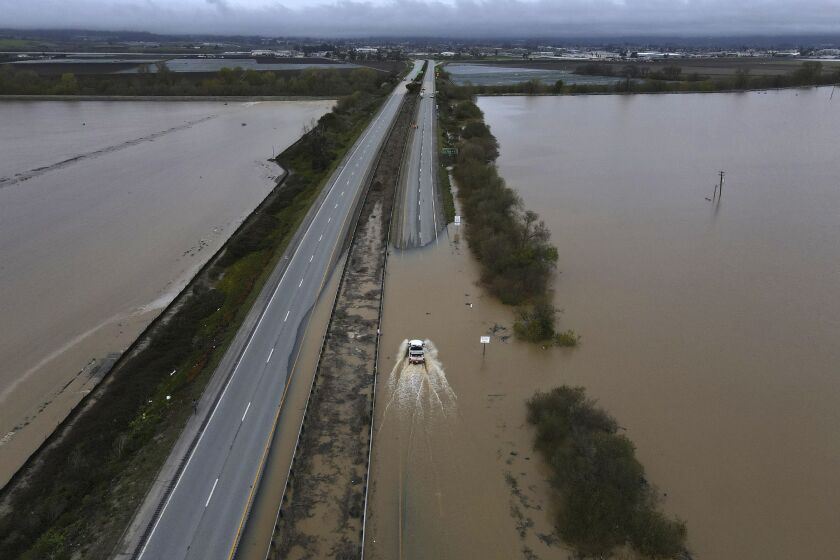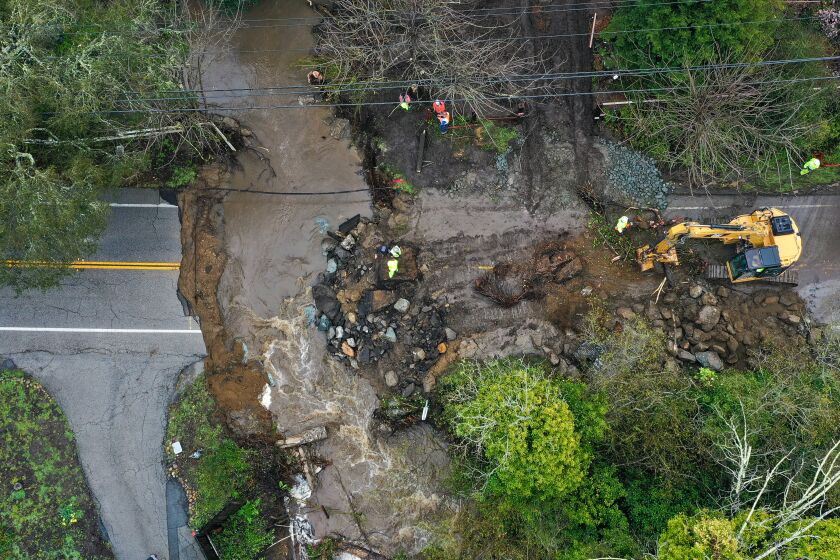
An atmospheric river storm bearing down on California will drop more rain and snow this week, sparking fresh concerns about additional flooding and snowmelt in the already soaked state.
The storm, which originated near Hawaii, is expected to intensify Monday into Wednesday. It will create “considerable flooding impacts below 5,000 feet elevation across much of the California Coast and Central Valley and over the southern Sierra Nevada foothills,” the National Weather Service said.
Rivers, creeks and streams in several areas are once again forecast to overtop — including some, such as the Cosumnes, Salinas and Russian rivers, that are still swollen from a similar storm last week.
“Antecedent conditions are extremely wet and the watersheds are primed, so it’s not going to take a whole lot of precipitation to result in immediate runoff and rises on rivers and streams, and flooding in urban areas,” UCLA climate scientist Daniel Swain said during a briefing Monday.
Last week’s storm spurred dozens of water rescues and saw thousands of Californians under evacuation orders. Friday night, heavy rain breached a levee on the Pajaro River, flooding an entire town and trapping scores of residents — many of them migrant farmworkers.
Heavy rain remains a top concern with the incoming system, and the weather service has issued more than 30 flood watches and warnings in the state, with heaviest impacts expected as the system moves from the Central Coast toward the southern Sierra foothills. Flood watches have also been issued in Northern California, including portions of Del Norte, Humboldt and Trinity counties.
Although the total precipitation from the incoming storm may not be higher than the storm last week, the flood risk could be significantly greater because of more intense rainfall and already moist conditions, Swain said.
“We just got all this rain, rivers are already running high, there’s still some residual snowmelt — all of those things point toward elevated flood risks with this event compared to the last,” he said.
The San Francisco Bay Area has already seen urban flooding, rock slides and debris flows, said weather service meteorologist Eleanor Dhuyvetter.
“Things are very saturated; the ground is ready to move,” Dhuyvetter said, adding that forecasters are “definitely looking at some flooding impacts for the heavier amounts going into Tuesday.”
The storm started as convection near Hawaii before maturing into a strong low-pressure system, Dhuyvetter said, and it is expected to link with some upper-level energy on Monday.
“We’ve been watching it, and it’s definitely been intensifying over the past 24 hours. Once it meets up with that upper-level energy, it’s going to quickly move and crash into the coast there, right by the Bay Area,” she said.
The storm is expected to be strongest in the Bay Area overnight Monday and into Tuesday, while the Central Valley and areas farther inland should see the brunt Tuesday afternoon into Wednesday, according to Brian Ochs, a meteorologist with the weather service in Hanford.
Inland areas of particular concern are Merced County near Bear Creek as well as portions of Mariposa, Fresno, Madera and Tulare counties, which will see the most rain, Ochs said. “Kern won’t be quite as much, but there could still be some local flooding impacts.”
Up to 6 inches of rain could fall in mountain areas as high as 7,000 feet, with up to 3 inches possible in foothills and 1.5 inches in the San Joaquin Valley, Ochs said.
Heavy, wet snow is also expected to fall in higher elevations, particularly in the Sierra Nevada, which will “further compound snow load impacts and issues,” the weather service said. The state has already seen a spate of roof collapses from heavy snow.
Tioga Pass and Mt. Whitney could see up to 48 inches of fresh powder, with up to 24 inches of snow at Mammoth Lakes.
Widespread rainfall is also expected in Southern California, including up to 7 inches in the mountains of southeastern Santa Barbara County and western Ventura County, with the peak of the storm expected on Tuesday. The Ventura River may get close to flood stage, and smaller creeks and streams are expected to fill, said Mike Wofford, a meteorologist with the weather service office in Oxnard.
“In Santa Barbara County, there’s a ton of streams — the mountains are right there in their backyard — and so all that water just comes streaming down,” Wofford said. “There’s tons of them, and they are going to be filling up, and some of them spill out onto the highway so there will probably be some issues on 101.”
Freeway closures, mudslides and debris flows are likely, he said. In the Los Angeles metropolitan area, up to 3 inches of rain is possible, along with associated clogged storm drains and flooded intersections, he said.
The storm is “a little shorter in duration than the last one was, but it’s higher intensity — we’re going to end up with more rain in L.A. that we did with the last one,” he added.
The California Governor’s Office of Emergency Services said Monday that it was positioning resources to fight flooding and respond to potential emergencies in nearly 20 counties across the state, including swift-water rescue teams in Fresno, Inyo, Sacramento, Monterey, Tulare, Los Angeles and San Luis Obispo counties.
The weather service is warning that the system may also bring the potential for thunderstorms and strong winds, with high wind warnings in effect in several regions. Coastal areas from Cloverdale to Big Sur could see gusts of up to 70 mph, while the Sacramento Valley, San Joaquin Valley and surrounding areas could see gusts of up to 60 mph.
The storm arrives on the heels of one of California’s wettest, snowiest winters on record. Nearly two dozen people were killed during a series of nine back-to-back atmospheric rivers in January, and at least 13 people were found dead after heavy snow piled up in the San Bernardino Mountains in late February and early March.
Statewide snowpack on Monday was 212% of normal for the date, while Oroville and Shasta — the state’s two largest reservoirs — were 76% and 63% full, respectively.
Forecasters feared the dampened soils, swollen streams and low-elevation snowpack would only exacerbate problems in the hours and days ahead.
“With so much water already, just any more moisture is going continue to cause impacts,” Dhuyvetter said.


